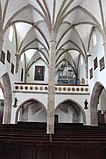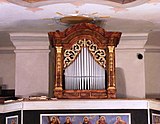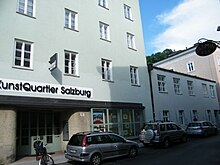Johann Christoph Egedacher
Johann Christoph Egedacher (born January 3, 1666 in Munich ; † September 13, 1747 in Salzburg ) worked as an organ builder in Salzburg . 1706–1747 he was court organ maker in the Prince Archbishopric of Salzburg .
Life
As the son of Christoph Egedacher, Egedacher belongs to the Straubing organ building dynasty of the Egedacher , who, together with the Butz and Freundt families, are considered to be the most important representatives of the southern German organ building school and thus of the Bavarian and (present-day) Austrian region.
At the age of about six he moved with his father from Munich to Salzburg, where he was enrolled as a pupil at the Benedictine grammar school on October 30, 1677. He probably received his training in his father's workshop in Salzburg- Mülln .
On June 25, 1703 he married Maria Forsthuber in the Muellner church , with whom he had eight children. Maria Anna was baptized on July 24, 1704 in Mülln, the other children in the old Andräskirche : Johann Christoph (October 22, 1706), Maria Eva (December 20, 1707), Johann Jakob (May 19, 1709), Johann Georg Kajetan (April 6, 1711), Maria Clara (April 8, 1713), Johann Rochus Egedacher (August 5, 1714) and Johann Simon Wolfgang (October 27, 1717). In his second marriage, Johann Christoph Egedacher was married to Maria Lanz. After the death of his father, Egedacher was awarded the position of the Salzburg court organ maker on August 6, 1706, with a monthly salary of 12 fl. 30 kr. During his lifetime, in 1703, on the occasion of the planned expansion of the Salzburg cathedral organ, he made his first study trip to Trento to the organ of the council church "Santa Maria Maggiore". On a second trip to Strasbourg in 1717 , he visited Andreas Silbermann , examined the organ he had built for the Strasbourg Cathedral with him , and bought his recipe for a preparation against "worm damage".
Egedacher first had his workshop in Salzburger Augustinergasse 2, at the corner of Mülleggstrasse 17, later in the house at Bergstrasse 12, which in 1713 was called the Murersche and Eggedacher houses . According to a so-called description of the soul , he had three journeymen in 1713: Wilhelm Stalls from Franconia , Anton Singstoller from Landshut and Joseph Dözer .
His two most important works are likely to be the expansion (1705/06) and fundamental improvement (1718) of the Salzburg cathedral organ and the new construction (1714–1716) of the large Liebfrauen organ in the Salem cathedral . In addition, more than 25 new organs can be verified by him.
Active as an organ builder until the end, he died at the age of 83 and was buried in 1747 at the St. Sebastian cemetery in Salzburg .
His daughter Maria Anna Egedacher, born on July 24th, 1704 in Mülln, was later ... a royal court singer [and] received [...] an exceptionally high monthly salary of 25 florins due to her excellent [!] Voice, which after her on April 17th 1730 marriage with the court tenorist Giuseppe Francesco Lolli from Bologna was reduced, but still 16 fl. Fraud .
One portrait shows Johann Christoph Egedacher with Johann Babtist Graf Thurn-Valsassina and Leopold Mozart . The picture was in the painting collection of Franz Laktanz Graf von Firmian at Schloss Leopoldskron until 1830 ; the depiction is considered lost.
List of works
The list includes some of his proven new builds.
The size of the instruments is indicated in the fifth column by the number of manuals and the number of sounding registers in the sixth column. A capital “P” stands for a separate pedal.
| year | place | church | image | Manuals | register | Remarks |
|---|---|---|---|---|---|---|
| 1705-1706, 1718 | Salzburg | Salzburg Cathedral |

|
III / P | 42 | 1706: In the contract for the expansion of the Salzburg cathedral organ of December 1, 1704, Egedacher announced that not only would the large organ that had been newly erected in the ducal cathedral church be increased with two new flutes or that had been turned since then , but also the organ in the cathedral in Trento also incorporate rary register to the Different tongues Werckhen alongside other of these local Domb OrgL ... . 1718: From May to September 1718 Egedacher worked again on the cathedral organ with the intention of finishing the great work in a better state than it ever was . He made around 2000 new pipes and provided them with new wind sticks. However, with a slightly different disposition, the organ did not have more registers. The result was an instrument that featured easy-to-use playing mechanics and a pure tone. |
| 1705/06 | Iron ore | Parish Church of St. Oswald | Event: After his sister Maria Scholastica (born Nov. 18, 1674 in Mülln) came to help him with the construction of the organ in the upper church and two other small works, she died of a raging illness and was buried on Feb. 22, 1706 in Eisenerz, St. Oswald. | |||
| 1706 | Stuhlfelden | Parish church | ||||
| 1709 | Windischmatrei | positive | ||||
| 1710-1711 | Mattsee | Mattsee Abbey | ||||
| 1711 | Matrei in East Tyrol | Niklaskirche | I. | 4th | positive | |
| 1712 | Salzburg | Allerseelenkirche (today the house at Kaigasse 10) | Acquired for approx. 155 guilders from the so-called Black Brotherhood , officially called the All Souls Brotherhood . The last repair is proven for the year 1800 and was made by court organ maker Johann Ev. Schmidt for 20 guilders. In 1802 the instrument, presumably a positive, was sold to Anif for 120 guilders. | |||
| 1712 | Reichersberg | Parish Church (demolished in 1820). Transferred to the Münsteuer parish church in 1787 . |

|
I / P | 8th | In the course of the reforms Emperor Joseph II. Conducted profanation of the parish church Reichersberg took place in 1787 the transfer of the organ in the neighboring parish church of St.. Paul in coin tax. Very good condition. → organ |
| 1713 | Gmünd in Carinthia | Parish Church of the Assumption of Mary | I / P | 9 | Apparently set up by his journeyman Josef Dözer, also Dölger. | |
| 1713 | Upper walls | Pilgrimage church | I. | 6th | ||
| 1714 | Salzburg | Aula Academica | II / P | 24 | ||
| 1714 | St. Veit im Pongau | Parish Church of St. Vitus |

|
I / P | 7th | largely original |
| 1714-1716 | Salem (Baden) | Salem Minster (Liebfrauen organ) | II / P | 30th | ||
| 1715 | Salzburg | Kollegienkirche | positive | |||
| 1717 | Kirchental | Sanctuary of Our Lady | I / P | 7th | not received | |
| 1717 | Burghausen | St. Jacob | ||||
| 1719-1720 | Salem | Salem Minster (Trinity Organ) | Prospectus pipes received | |||
| 1720 | Kuchl | Parish church | ||||
| 1720-1721 | Salem | Imperial Abbey | Relocation of the Rückpositiv, repair of the Choir Positive, new construction of a supporting organ | |||
| 1721 | Salzburg | Kollegienkirche | Merging two separate organs into one instrument | |||
| around 1723 | Salzburg |
Sacellum
(now in the Astätt branch church ) |

|
I. | 4th | Johann Nepomuk Carl Mauracher removed the positive from the Sacellum ( Salzburg ) in 1866 and sold it to the church in Astätt. On January 15, 1868, he received 140 guilders for this . It was preserved in the Astätt branch church . |
| 1724 | Irrsdorf | Branch church | ||||
| 1729 | Neumarkt am Wallersee | Parish church | ||||
| 1729 | Köstendorf , since 1863 in the Pfongau branch church in Neumarkt am Wallersee | Parish church Köstendorf |

|
I. | 5 | The organ cost 434 florins in 1729. The instrument was rebuilt in 1863 by Matthäus Mauracher and installed in the Pfongau branch church in Neumarkt , and a pedal was added in 1893 by Albert Mauracher . Restoration in 2017 by Orgelbau Linder . 76.1% of the pipe material comes from Johann Christoph Egedacher. |
| 1730 | Radstadt | St. Loretto ob Lerchen | ||||
| 1731 | Abtenau | Parish church | ||||
| 1731 | Henndorf am Wallersee | Parish church | ||||
| 1732 | Gleink | Benedictine monastery | II / P | 20th | Housing preserved; 1993 reconstruction by Bernhardt Edskes | |
| 1735 | Sankt Jakob am Thurn | Parish church | positive | |||
| around 1735 | Saalfelden | Dean's Church | ||||
| 1736 | Kramsach | Pilgrimage basilica and Mariathal parish church | II / P | 21st | Built as a dowry for a daughter of Egedacher who entered the Dominican convent in Marienthal in 1736 . | |
| 1737 | Mondsee | Mondsee Monastery | Choir organ | |||
| 1737 | Goldegg in Pongau | Parish church | ||||
| 1737 | Zersdorf | Branch church | ||||
| 1737 | Thalgau | Dean's Church | ||||
| 1737 | Dürrnberg | Pilgrimage church | Probably a repair of an existing instrument. | |||
| 1738 | Prien am Chiemsee | Parish Church of the Assumption | 1994 Organ work with III / 50 and new Rückpositiv from Gerald Woehl | |||
| 1739 | Gmunden | Parish church of Gmunden | ||||
| 1740 | Herrenchiemsee , monastery ; in Tittmoning since 1816 | now in St. Laurentius |

|
II / P | 19th | Originally created for the Herrenchiemsee Monastery , with the housing and parapet probably coming from Georg Anton Kidl and Sebastian Mayr; Prospectus and parapet received. When the church burned in 1815, Rochus Egedacher's previous instrument from 1779 was destroyed. |
| 1740 | Teisendorf | Parish church | 8th. | |||
| 1741 | Linz | Carmelite Church | II / P | 24 | Housing preserved; 1969 new factory by Walcker-Mayer |
literature
- Georg Brenninger: Organs in Old Bavaria . Munich 1978, ISBN 3-7654-1704-1 .
- Anton Dawidowicz : master organ builder and organs in East Tyrol . Inaugural dissertation Vienna 1949.
- Alois Forer: Organs in Austria . Vienna / Munich 1973, ISBN 3-7031-0362-0 .
- Rupert Frieberger : Organ building in Upper Austria in the 17th and 18th centuries . With special consideration of existing instruments. Innsbruck 1984. (Musicological contributions from the Schlägler music seminars, Volume 3).
- Ernst Hintermaier: The Salzburg Court Chapel from 1700 to 1806 . Dissertation University of Salzburg 1972.
- Rudolf Quoika: Egedacher, Johann Christoph. In: New German Biography (NDB). Volume 4, Duncker & Humblot, Berlin 1959, ISBN 3-428-00185-0 , p. 321 f. ( Digitized version ).
- Barbara Rettensteiner: Organ and organist report Salzachpongau . Diploma thesis University Mozarteum Salzburg 2001.
- Josef Saam: The old Passau organ builders . Their origin and their work from 1467 to 1744. In: Ostbairische Grenzmarken. Passau 1977, pp. 108-137. (Passau Yearbook for History, Art and Folklore).
- Roman Schmeißner: Organ building in Salzburg's pilgrimage churches , Duisburg & Cologne: WiKu-Verlag 2015, ISBN 978-3-86553-446-0 (also dissertation: Studies on organ building in pilgrimage churches of the Archdiocese of Salzburg , Mozarteum University 2012).
- Heinz Schuler : Egedacher . Origin, life and work of a southern German organ builder family from 1624 to 1786. In: Genealogie , Jg. 27 (1978), No. 12, pp. 369–389.
- Hermann Spies : The Salzburg Great Cathedral Organs . Augsburg 1929.
- Gerhard Walterskirchen: Organs and Organ Builders in Salzburg from the Middle Ages to the Present . Dissertation University of Salzburg 1982.
Web links
Individual evidence
- ↑ Death book - STB2 | Salzburg-St. Andrae | Salzburg, rk. Diocese | Austria | Matricula Online. Retrieved December 11, 2019 .
- ^ Anton Dawidowicz: master organ builder and organs in East Tyrol . Inaugural dissertation Vienna 1949, p. 193.
- ^ Ernst Hintermaier: The Salzburg Court Chapel from 1700 to 1806 . Dissertation University of Salzburg 1972, p. 84. Quoted from: Gerhard Walterskirchen: Orgeln and Organ Builders in Salzburg from the Middle Ages to the Present . Dissertation University of Salzburg 1982, p. 83.
- ^ Salzburger Landesarchiv: Doppler house chronicle : Haus Bergstrasse 12 (C No. 507). Quoted from: Gerhard Walterskirchen: Organs and Organ Builders in Salzburg from the Middle Ages to the Present . Contributions to 700 years of organ building in the city of Salzburg. Dissertation: Salzburg 1982, p. 84.
- ^ Salzburger Landesarchiv: Secret Archive : XXVII / 16. Quoted from: Gerhard Walterskirchen: Organs and Organ Builders in Salzburg from the Middle Ages to the Present . Contributions to 700 years of organ building in the city of Salzburg. Dissertation: Salzburg 1982, p. 84.
- ↑ Quoted from: Heinz Schuler: Mozart's Salzburg friends and acquaintances . Biographies and Commentaries, Wilhelmshaven 1998, p. 178.
- ↑ In the estate inventory there is a picture "whereupon the portrait of Sr. hochfstl. Grace, then Mr. Egedacher and Mr. Mozart. ” In: Johann Riedel: Salzburgs Canon . From 1514-1806. Announcements from the Society for Salzburg Regional Studies (1867), p. 201, entry 279. (born 1863–1941 online) online , accessed on October 11, 2015.
- ^ Gerhard Walterskirchen: Organs and Organ Builders in Salzburg from the Middle Ages to the Present . Contributions to 700 years of organ building in the city of Salzburg, dissertation Salzburg 1982, p. 90a.
- ↑ Quoted from: Otmar Heinz: Frühbarocke Orgeln in der Steiermark . On the genesis of a southern German-Austrian type of instrument of the 17th century, Berlin 2012, (Research on the historical regional studies of Styria, published by the Historical Commission for Styria, Volume 53), p. 161.
- ↑ Rupert Klieber: Brotherhoods and associations of love after Trient . Peter Lang, Frankfurt am Main a. a. 1999, ISBN 3-631-34044-3 , pp. 175 .
- ↑ To the organ builder Joh. Nep. Mauracher for the transferred organ with 4 registers (from the Sacellum) 140 fl.
- ^ Rupert Gottfried Frieberger: Organ building in Upper Austria in the 17th and 18th centuries. Innsbruck 1984, p. 212.
- ^ Austrian art topography 10 : The monuments of the political district of Salzburg; Volume 1: Salzburg Court District (ÖKT 10/1), ed. from the Art History Institute of the kk Central Commission for Monument Preservation, Vienna 1913, p. 79.
- ^ Alois Linder: Filialkirche St. Martin Pfongau . Dismantling report for the restoration of the Matthias Mauracher organ. Nußdorf am Inn, May 24, 2017, pp. 2, 15 and 18.
- ^ Roman Matthias Schmeißner: Studies on organ building in pilgrimage churches of the Archdiocese of Salzburg . Dissertation University Mozarteum Salzburg 2012, p. 24.
- ↑ Georg Brenninger: Organs in Old Bavaria . Munich 1978, p. 194.
- ↑ Georg Brenninger: Organs in Old Bavaria . Munich 1978, p. 72 u. 81.
- ↑ Georg Brenninger: Organs in Old Bavaria. Munich 1978, p. 81.
| personal data | |
|---|---|
| SURNAME | Egedacher, Johann Christoph |
| BRIEF DESCRIPTION | Salzburg organ builder |
| DATE OF BIRTH | January 3, 1666 |
| PLACE OF BIRTH | Munich |
| DATE OF DEATH | September 13, 1747 |
| Place of death | Salzburg |

